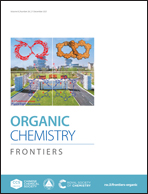Diboron-controlled product selectivity switch in copper-catalyzed decarboxylative substitutions of alkynyl cyclic carbonates†
Abstract
This paper presents a density functional theory study of the mechanisms and origins of diboron-controlled divergent product selectivity in the copper-catalyzed decarboxylative substitution of alkynyl cyclic carbonates. Calculation results indicate that a copper alkoxide intermediate, which is derived via the third step, i.e., CO2 extrusion, selectively determines formation of an (E)-1,2-borylated 1,3-diene product or an α-hydroxyallene product. The selected product depends on the diboron. Frontier molecular orbital analysis showed that the switchable product selectivity results from the differences among the diboron lowest unoccupied molecular orbital energies. The results show that a monoborylated allene is the precursor to the α-hydroxyallene product but not to the (E)-1,2-borylated 1,3-diene product. The stereoselectivity-determining step is Cβ-borylation. Steric hindrance is the dominant factor in the stereoselectivity.



 Please wait while we load your content...
Please wait while we load your content...